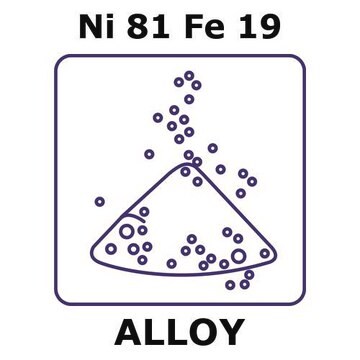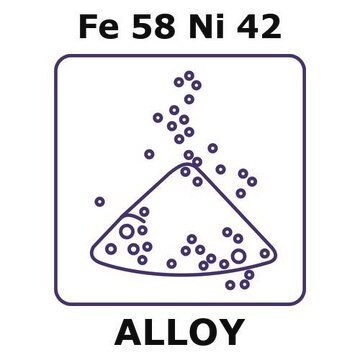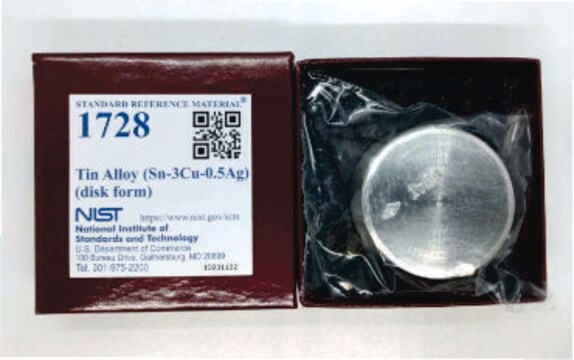677426
Iron-nickel alloy
nanopowder, <100 nm particle size (BET), ≥97%
About This Item
Prodotti consigliati
Descrizione
Fe/Ni (0.55:0.45)
Livello qualitativo
Saggio
≥97%
Stato
nanopowder
Composizione
Fe, 55%
Ni, 45%
Impiego in reazioni chimiche
reagent type: catalyst
core: nickel
Area superficiale
>14.4 m2/g
Dimensione particelle
<100 nm (BET)
Note legali
Avvertenze
Danger
Indicazioni di pericolo
Consigli di prudenza
Classi di pericolo
Aquatic Chronic 3 - Carc. 2 - Flam. Sol. 2 - Self-heat. 2 - Skin Sens. 1 - STOT RE 1 Inhalation
Organi bersaglio
Lungs
Codice della classe di stoccaggio
4.2 - Pyrophoric and self-heating hazardous materials
Classe di pericolosità dell'acqua (WGK)
WGK 2
Punto d’infiammabilità (°F)
69.8 °F
Punto d’infiammabilità (°C)
21 °C
Scegli una delle versioni più recenti:
Possiedi già questo prodotto?
I documenti relativi ai prodotti acquistati recentemente sono disponibili nell’Archivio dei documenti.
I clienti hanno visto anche
Articoli
An article concerning self-propagating reactions induced by mechanical alloying, presented by Sigma-Aldrich.com.
Professor Hui Mao explores the use of superparamagnetic iron oxide nanoparticles (INOPs) that offer an alternate contrast-enhancing mechanism.
Professor Yadong Yin (University of California Riverside, USA) examines both direct (thermal decomposition, solvothermal, hydrothermal) and indirect (templated) synthesis methods of magnetite nanocrystals and reviews in detail the landscape of these various synthetic methods for magnetite nanocrystal and their applications in magnetic assembly, magnetic hyperthermia, and Li-Ion batteries.
Magnetic materials permeate numerous daily activities in our lives. They are essential components of a diversity of products including hard drives that reliably store information on our computers, decorative magnets that keep the shopping list attached to the refrigerator door, electric bicycles that speed our commute to work, as well as wind turbines for conversion of wind energy to electrical power.
Il team dei nostri ricercatori vanta grande esperienza in tutte le aree della ricerca quali Life Science, scienza dei materiali, sintesi chimica, cromatografia, discipline analitiche, ecc..
Contatta l'Assistenza Tecnica.













